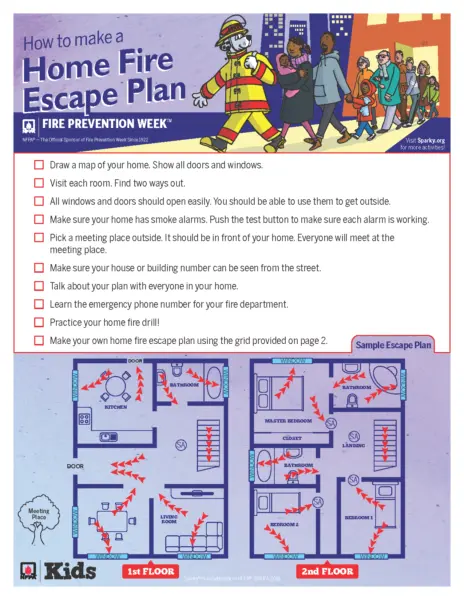
Click to download the NFPA Home Fire Escape Plan.
When it comes to protecting your home and family, are you protected from the danger of fire? Make sure your home has working smoke and fire alarms, and make sure to develop and practice a family escape plan.
Fire can strike anyone, anywhere, anytime. A burglar won’t steal your family photo albums, but a fire will. Jewelry can be replaced, but baby pictures can’t. Without smoke detectors, your home will never be secure against one of the most dangerous intruders.
When located on all levels of a residence and in all bedrooms, monitored detectors provide the best kind of early warning fire protection whether you are home or away.
Did you know?
- Half of home fire deaths result from fires reported between 11 p.m. and 7 a.m., during which only one in five home fires were reported.
- Three out of five home fire deaths between 2010-2014 happened from fires in homes with no smoke alarms or no working smoke alarms.
- One-quarter of home fire deaths were caused by fires that started in the bedroom. Another quarter resulted from fires in the living room, family room or den.
- In 2015, U.S. fire departments responded to an estimated 365,500 home structure fires. These fires caused 2,560 deaths, 11,075 civilian injuries, and $7 billion in direct damage.
- Cooking equipment is the leading cause of home fire injuries, followed by heating equipment.
- Smoking materials are the leading cause of home fire deaths.
- According to an NFPA survey, only one-third of Americans have both developed and practiced a home fire escape plan.
- Almost three-quarters of Americans do have an escape plan; however, less than half ever practiced it.
- Working smoke alarms cut the risk of dying in reported home fires in half.
- In fires considered large enough to activate the smoke alarm, hardwired alarms operated 94% of the time, while battery powered alarms operated 80% of the time.
- When smoke alarms fail to operate, it is usually because batteries are missing, disconnected or dead.
Here are some ways you and your family can develop and practice a fire escape plan:
- Install smoke alarms in every sleeping room, outside each separate sleeping area, and on every level of the home. Install alarms in the basement. Larger homes may require additional smoke alarms to provide a minimum level of protection.
- Interconnect all smoke alarms throughout the home for the best protection. When one sounds, they all sound. Make sure you can hear the sound of the smoke alarm.
- Install smoke alarms and alert devices that meet the needs of people who are deaf or hard of hearing. When the smoke alarm sounds, strobe lights flash to alert people who are deaf or hard of hearing of a possible fire when they are awake. When people who are hard of hearing are asleep, a loud, mixed, low-pitched sound alert device should be used to wake them. They may find a pillow or bed shaker is helpful to wake them. These devices are activated by the sound of the standard smoke alarm.
- Smoke alarms with non-replaceable (long-life) batteries are designed to remain effective for up to 10 years. If the alarm chirps, warning that the battery is low, replace the entire smoke alarm right away. For smoke alarms that do not have non-replaceable (long-life) batteries, replace batteries at least once a year. If the alarm chirps, replace only the battery.
- Draw a map of your home by using the NFPA’s grid with all members of your household, marking two exits from each room and a path to the outside from each exit.
- Practice your home fire drill twice a year. Conduct one at night and one during the day with everyone in your home, and practice using different ways out.
- Teach children how to escape on their own in case you can’t help them.
- Make sure the number of your home is clearly marked and easy for the fire department to find.
- Close doors behind you as you leave – this may slow the spread of smoke, heat and fire.
- Once you get outside, stay outside. Never go back inside a burning building.
(Statistics and tips via National Fire Protection Association)















